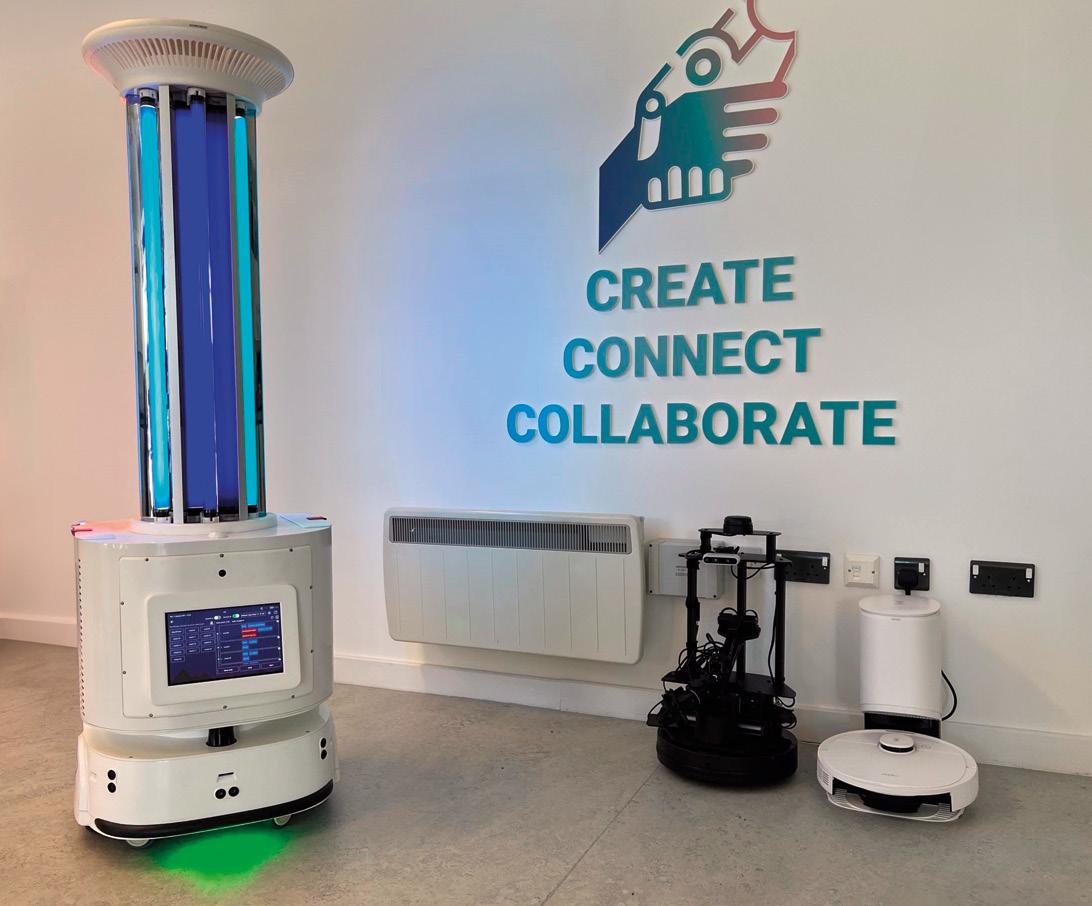
7 minute read
Is AI reinforcing inequality?
Through her part in the TAS Hub Trustworthy Human Robot Teams project and an intensive review of AI research, Professor Pauline Leonard is exploring questions about the role of technology in augmenting social inequalities, discrimination and injustice.
“The key question, from my point of view as a sociologist, is ‘How can we design and trust AI to deliver social aims of equality, fairness and social justice’,” commented Pauline, sociology professor and Executive Director of the Web Science Institute (WSI).
AI is taking root in almost every aspect of our lives, increasingly playing a part in determining the outcomes of mortgage, credit, job and welfare applications, as well as less consequential activities such as searching on Google, ordering the weekly shop or tracking your morning run.
We might assume that such technology is objective and neutral and even that machinedriven systems might be capable of correcting bias and discrimination, yet a growing body of evidence suggests otherwise.
“The COVID pandemic accelerated our reliance on online technologies in every aspect of our lives,” said Pauline, “and through an increasing number of stories in the media, it highlighted the way that AI was impacting differently on different social groups, particularly in terms of unequal outcomes. In many cases, it was racial identity which was unequally treated.”
This led Pauline to conduct a review of issues of AI bias.
“Over recent years, compelling evidence has exposed the racism and sexism embedded in many contemporary applications of AI,” she explained. In particular, datadriven Automated Decision Making (ADM) technologies, which make decisions through, for example, algorithms or rules based on correlations between datasets, have been shown to embed bias.
ADMs are now widely used in the United States and are spreading rapidly to Europe. Yet research has shown that many ADMs have bias built into their very design: certain systems deny loans, mortgages and credit cards to minorities; profile non-white faces as more likely to commit crimes; preferentially select white candidates or those with traditionally Western names for recruitment; refuse, in an AI-judged beauty contest, to identify any woman as beautiful who did not have a white face; and even fail to recognize non-white skin, making self-driving cars more likely to drive into Black pedestrians and soap dispensers more likely to release soap onto white hands.
“Many of the ADM systems currently in use default human beings to a white-based physiognomy,” commented Pauline. “They are naturalising whiteness as a dominant social identity and reinforcing inequalities. The impact can be life-changing.”
Pauline’s research has shown that bias infuses AI at every stage: from design to outcomes and user experiences.
AI’s ‘white guy problem’
The first issue, explained Pauline, is what has been described as AI’s ‘white guy problem’: the lack of diversity amongst AI designers, coders, engineers, and programmers, as well as those in charge of ‘Big Tech’.
In 2018/2019 only 2.5 per cent of Google’s workforce was Black and 3.6 per cent were Latinx. At the same time, Facebook and Microsoft respectively reported that 4 and 5 per cent of the workforce was Black, and 6 per cent was ‘Hispanic’.
This is compounded by gender. In academia, less than 20 per cent of AI faculty hires and PhD recipients are women; while in industry, women comprise just 15 per cent of Facebook’s staff and 10 per cent of Google’s. Half of the women who enter the sector eventually leave it.
A 2019 report concluded that the gender gap in computing is worse now than in the 1960s.
Artificialising bias
The second problem, a consequence of the first, is what Pauline labels ‘artificialising bias.’ The concept, which she developed, aims to capture the way that AI and AI tools might embed bias through their very usage and development, through their design and also their outcomes.
“We need to ask the question, what are the consequences of having an artificially selected ‘bunch of young white guys’ designing technologies?” continued Pauline.
“Who you recruit becomes who designs the technologies, and if you only have a very narrow section of the population designing how AI can be used in, for example, welfare benefits or women’s health, they won’t necessarily have the right kind of experience to inform the use of those AI’s, leading to biased outcomes.
“I describe these AI designs as engaging in a project of ‘artificialising bias’ as their social outcomes are routinely constructed to artificially bolster white, male, middle-class privilege, marginalising Black and ethnic minority women in particular.”
The uses and direction of the development of technology reflect the priorities of the holders of social and economic power. The evidence shows that those with the power to design and build digital systems can reflect their values and visions of the world in the decisions these systems make.
Zappy the robot cleaner
A third bias inflecting AI became evident to Pauline during research funded by the UKRI TAS Hub. Trustworthy Human Robot Teams was a multi-disciplinary project with the University of Nottingham and Kings College London, which looked at how humans and AI, in the form of robots, could work together in the context of industrial cleaning.
“The project began during COVID when, in some settings, industrial levels of sanitation were essential. Involving machines allows ultra-violet light to be used, so robots are a possible way forward,” explained Pauline.
Computer scientists and engineers at Nottingham developed a prototype cleaning robot, known as ‘Zappy’. The project considered the effectiveness of the robot’s cleaning and how it would be received and trusted.
Pauline examined the responses of human industrial cleaners.
Many of the male cleaners were excited by the idea of working with a robot, drawing on science fiction films in their responses. Some raised concerns about what would happen if Zappy went out of control.
“While the men looked forward to a more technological future, the women tended to be much more cautious,” said Pauline.
The female cleaners were concerned that Zappy would not be as skilled as a human,
would not be flexible or mobile enough to get into small spaces or have the fine motor skills that much cleaning demands.
“That Zappy was interpreted more positively by men is an interesting reflection of the fact that in industrial cleaning, male cleaners dominate, whereas in domestic cleaning women dominate,” commented Pauline. “Industrial cleaning is seen as tougher and more masculine, whereas domestic cleaning is thought of as cleaning toilets and other people’s food spills. It is interesting how both the design and the responses of the human cleaners reflect larger structural differences in the workplace.
“Where some of my previous research had identified how race was an embedded structural inequality in some AIs, the outcomes of this work highlighted the role of gender.
“It became clear that ‘bias’ – our preconceived judgments, attitudes and experiences, which are often drawn from powerful social stereotypes, of skill, ability and appropriacy as to who does what –penetrates all aspects of the AI process,” said Pauline.
Bias in AI must not go unchallenged
This recognition of AI as a racial, gendered and classist system of governance that can reassert, renew, and normalise existing bias, must not go unnoticed or unchallenged. The good news is that activists and academics are increasingly exposing injustices and arguing that the reliance of key institutions of governance on ADM systems in the distribution of essential services is a human rights issue.
The University of Southampton is uniquely well-placed to address this issue.
“Work on Trust, Bias and effective governance is absolutely central to what we’re doing,” commented Pauline. “Through the sociotechnical approach of the Web Science Institute and the TAS Hub, computer scientists work alongside social scientists, philosophers, and lawyers, to debate these ethical questions every day.”











